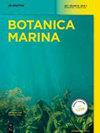环境梯度影响西北太平洋形态相似的莼菜物种的地理分化和低遗传多样性
IF 1.4
4区 生物学
Q2 MARINE & FRESHWATER BIOLOGY
引用次数: 0
摘要
莼菜属物种是重要的基础海洋初级生产者,分布于世界各地。在西北太平洋(NWP),这些物种的数量和多样性尤为丰富,它们在那里经历了明显的纬度梯度环境异质性。然而,目前还不清楚这种动态条件能在多大程度上改变这些生物的表型和遗传模式,这可能反映了历史和当代生物与非生物因素的影响。在此,我们利用质粒 rbcL 和 tufA 基因序列评估了北大西洋莼菜物种特异性之间和内部的遗传模式。尽管我们最初是根据形态鉴定来确定石莼的目标,但我们发现了八个被形态相似性掩盖的石莼遗传实体。除了Ulva linza-procera-prolifera和U. lactuca-reticulata复合体外,这些遗传实体中有六个被恢复为单个物种(即U. australis、U. ohnoi、U. californica、U. compressa、U. lacinulata和U. arasakii),并显示出生物地理模式,这可能是由海面温度和洋流扩散的克线所解释的。在种内水平上,根据 rbcL(0-0.3 %)和 tuf A(0-0.9 %)数据,所有遗传实体都显示出较低的遗传变异和分化。我们的研究结果为通过西北太平洋研究形态相似的莼菜物种的种内和种间遗传模式特征提供了见解。然而,要了解这种模式的基本机制以及相关的生态和进化影响,还需要进一步的研究。本文章由计算机程序翻译,如有差异,请以英文原文为准。
Environmental gradients influence geographic differentiation and low genetic diversity of morphologically similar Ulva species in the Northwest Pacific
Species classified in the genus Ulva are important foundational marine primary producers distributed worldwide. These species are particularly abundant and diverse through the northwest Pacific (NWP) where they experience marked latitudinal gradients of environmental heterogeneity. It is unclear, however, to what extent such dynamic conditions can modulate phenotypic and genetic patterns in these organisms, potentially reflecting the influence of historical and contemporary biotic and abiotic factors. Here, we assessed inter- and intra-specific genetic patterns of Ulva species through the NWP using plastid rbc L and tuf A gene sequences. Although we initially targeted Ulva australis based on morphological identification, we recovered eight Ulva genetic entities masked by morphological similarities. Except for the Ulva linza–procera–prolifera and U. lactuca–reticulata complexes, six of these genetic entities were recovered as individual species (i.e., U. australis , U. ohnoi , U. californica , U. compressa , U. lacinulata , and U. arasakii ), and showed biogeographic patterns likely explained by clines in sea surface temperature and ocean current dispersal. At intra-specific level, all the genetic entities showed low genetic variation and divergence based on rbc L (0–0.3 %) and tuf A (0–0.9 %) data. Our results provide insights regarding intra- and inter-specific genetic patterns characterizing morphologically similar Ulva species through the NWP. However, further studies are needed to understand the mechanisms underpinning such patterns and the associated ecological and evolutionary implications.
求助全文
通过发布文献求助,成功后即可免费获取论文全文。
去求助
来源期刊

Botanica Marina
生物-海洋与淡水生物学
CiteScore
4.10
自引率
4.50%
发文量
43
期刊介绍:
Botanica Marina publishes high-quality contributions from all of the disciplines of marine botany at all levels of biological organisation from subcellular to ecosystem: chemistry and applications, genomics, physiology and ecology, phylogeny and biogeography. Research involving global or interdisciplinary interest is especially welcome. Applied science papers are appreciated, particularly when they illustrate the application of emerging conceptual issues or promote developing technologies. The journal invites state-of-the art reviews dealing with recent developments in marine botany.
 求助内容:
求助内容: 应助结果提醒方式:
应助结果提醒方式:


